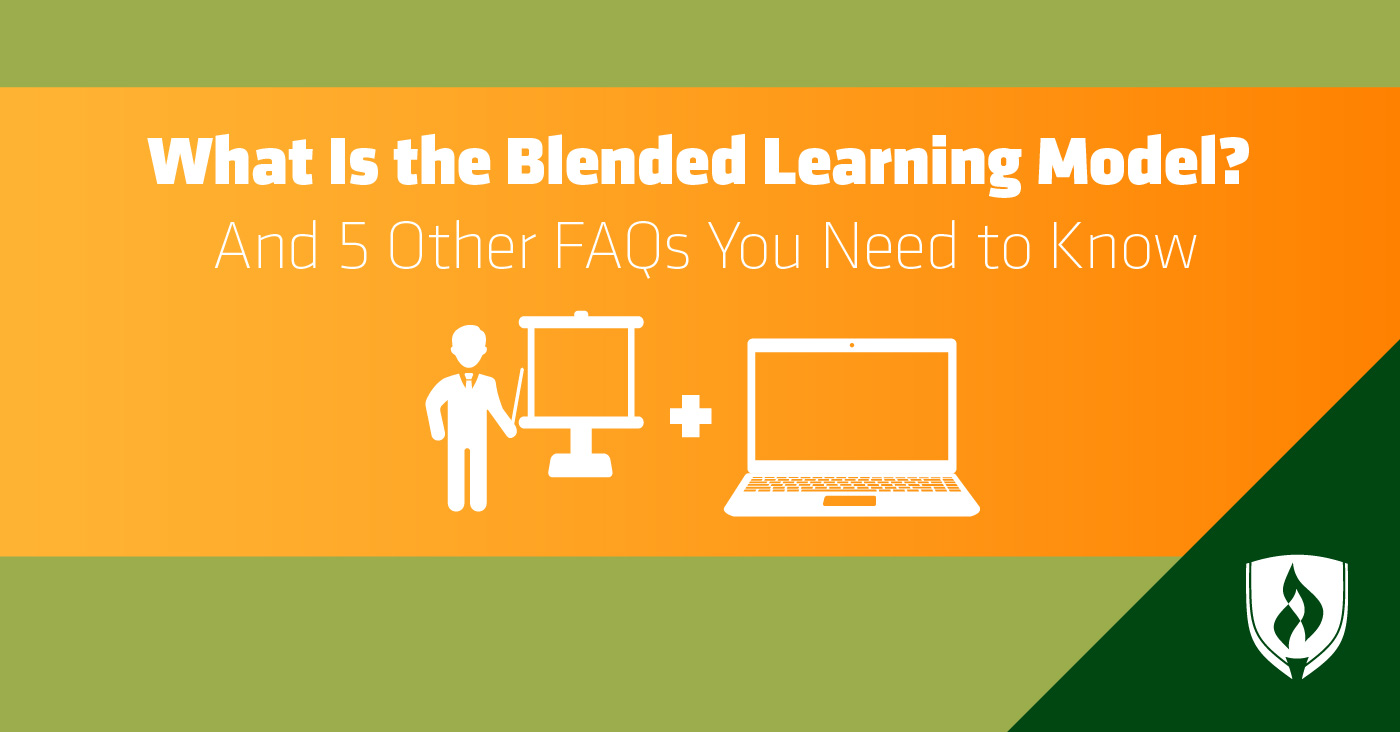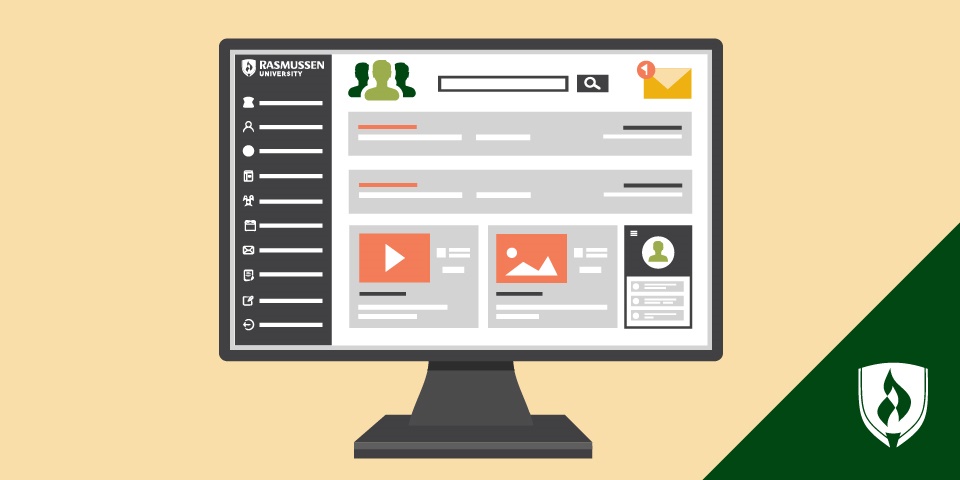
The classroom of 2018 is a far cry from what generations prior may remember from their college days. Tablets, online lectures, videoconferencing and online discussion posts are all relatively new components commonly found in today’s learning environments—quite the jump from a pencil and a notebook in a traditional brick-and-mortar-style classroom.
This infusion of technology and new learning options has led to a need for new terms to describe the modern educational landscape. One such term that has risen to the forefront is blended learning.
Unfamiliar with the term? You’re in the right place. In this article, we’ll define what the blended learning model is and answer a number of frequently asked questions you may have about it.
6 Common questions about the blended learning model
1. What is blended learning, anyway?
In simple terms, blended learning is an approach to education that mixes elements of online learning and traditional, in-classroom learning. That said, it can be difficult to pinpoint where traditional or online learning stops and where blended learning begins.
For example, does a traditional class in which students watch video lectures online count as blended learning? Likewise, does an online class that requires students to complete in-person lab work fit the definition? Blendedlearning.org offers some helpful guidelines for defining what is or isn’t a blending learning program:
- Blended learning is any formal education program in which the student learns at least partially online with some element of control over time, place, path or pace.
- A blended learning program requires students to learn at least partially under the supervision of an instructor in a traditional brick-and-mortar location.
- A blended learning program must integrate both online and in-person modalities in a way where they build upon each other—materials should build upon; not repeat the same information.
2. Why not just offer these courses fully online?
It’s true that some students prefer fully online courses and the flexibility that comes with them—so why would a school offer a blended format? It’s worth considering that some subjects and courses are more naturally suited to in-person instruction. For example, it’s likely much easier for a nursing instructor to explain and demonstrate the technique for starting an IV line in a classroom where hands-on modifications can be made.
Another factor is that some students just don’t feel comfortable or at their best in fully online courses and have a strong desire for in-person instruction. Carrie Daninhirsch, assistant vice president of learning and teaching at Rasmussen College, says hybrid formats can work as a middle ground for students who aren’t quite comfortable with a fully online course.
“Many of these students are sort of looking for that first step to an online course but want a residential experience as well,” Daninhirsch says. “Blended courses allow new students to get comfortable in a residential space as they return to school, and they also teach them the tools required to succeed in an online format.”
3. Do students perform better in this model?
Whether it’s in a fully online, traditional or hybrid format, Daninhirsch says it’s a common misconception for students to believe one way of learning is objectively better than the other. Learning preferences vary from person to person.
“For students, it’s really about understanding how they learn best and not just thinking they can only do well online or in the classroom,” she says.
There is, however, some evidence of improved academic achievement for students in blended learning formats. One analysis of educational studies found students in online courses—particularly those that blend traditional and online work—performed better than those receiving solely face-to-face instruction. This is encouraging news for educators looking for new ways to supplement and structure their coursework and curricula. It is also believed that courses that incorporate online learning are increasingly aligned with the “real-world” work that students will be doing when they’ve earned their degrees.
“A blended learning course gives students the opportunity to get both the face-to-face residential experience while also preparing them for the realities of the workplace,” Daninhirsch says. “They’ll likely need to be able navigate systems and access online materials in their careers and so on—that’s something they can take with them.”
4. Are more schools adopting this model? Why?
While blended instructional models might not yet be the standard for all, more and more students and institutions are becoming comfortable with implementing elements of online learning into their curriculum. The motivations for schools embracing more online and blended learning formats vary, but there are some common reasons.
Overall, there has been growth in non-traditional student enrollment. Schools competing for these students have likely invested in technology to help facilitate online learning, which makes blended learning courses a natural progression.
“Individual institutions will approach online and blended learning differently, but this move toward online learning is responding to students’ need for more options,” Daninhirsch explains. “It’s a response by colleges who are trying to better understand their students’ needs and wants.”
Another potential motivator is the fact that more of the young, traditional students have come to expect elements of blended learning—they’ve spent their entire lives on the internet, have potentially completed K–12 coursework in a blended format and see online course components as the standard.
“Higher education has to respond to this change,” Daninhirsch says. “We have all of these students coming up through K–12, learning about and interfacing with technology in so many different ways. [What] if they get to college, and that isn’t addressed at all? There’s a gap there.”
5. What are some of the potential drawbacks to the blended learning model?
While some may sing the praises of hybrid or blended learning formats, others still point out a few potential disadvantages. It’s true that some courses might not be a natural fit for the format—a course focused on hands-on learning, for example, may prove harder to translate in a solely online environment.
It’s also true that a course following the blended learning format tends to have less flexibility, as the in-classroom components can be challenging for students with full-time work schedules or those who live far away from campus.
6. What are some ways technology is being implemented?
The blended learning format is enabled by several technologies. One of the most prominent tools is the use of learning management systems like Blackboard, D2L or Moodle. These platforms provide online students with a portal that connects them to course resources, grade information, online discussions and assignments.
Video conferencing tools can allow students working online or from multiple campuses to participate in larger group lectures and discussions, or even one-on-one instruction as needed. Video can also be used in other ways to enhance students’ learning experiences. Consider, for example, if an instructor gives an in-class presentation about a topic, and then also assigns students to watch a supplementary video online to help reinforce their learning.
Student collaboration is another area aided by technology. Tools like Google Docs allow students to work together on projects without necessarily being all in the same place at once.
Are online or blended classes in your future?
The blended learning model has been steadily gaining steam nationwide—and while it differs in some ways from a fully online learning style, there’s still a lot of crossover. If you’ve never taken an online or blended class, you’ll want to read up on a few pointers to make sure you’re successful. Our article, “What I Wish Someone Told Me Before Taking Online Classes,” will give you an excellent rundown of common pitfalls, misconceptions and advice for anyone new to the format.




